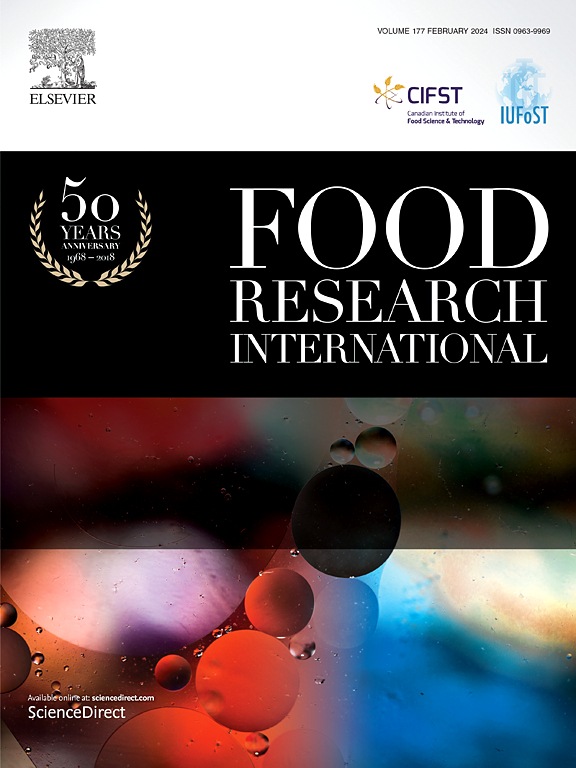“Growth Predictor”: A new predictive modelling and quantitative microbial risk assessment tool
IF 8
1区 农林科学
Q1 FOOD SCIENCE & TECHNOLOGY
引用次数: 0
Abstract
A new predictive modelling and quantitative microbial risk assessment (QMRA) software, developed in R, is available on-line (https://skandamis.shinyapps.io/Microbial-Growth-Predictor-Dashboard/). Primary model fitting is carried out with the Baranyi model. Secondary fitting and growth simulations are based on gamma models with or without interactions. The same gamma terms can be used for fitting and growth simulations under static or dynamic conditions. One of the novel features is the use of normal distributions to describe the variability in T, pH, aw, the levels of a single inhibitor and the inter-strain variability in growth limits. The QMRA is comprised of four consecutive modules from primary production until consumption. In addition to prevalence, the modules may also consider partition, mixing and cross-contamination. Variability can be introduced through a variety of probability distributions, for initial contamination, re-contamination, storage time and temperature, product characteristics, serving size and maximum population density. Fixed or variable log reductions during cooking, may be introduced as user-defined values or probability distributions, respectively, or estimated by a Bigelow thermal inactivation model. The trilinear primary growth model is used for estimating log changes, based on μmax obtained by gamma models. The QMRA outputs include graphical distribution of ingested dose and probability of illness (Pill), as well as tabular estimates. The user may select built-in dose-response models, or define the parameters values of exponential, beta-Poisson, beta-binomial and binomial dose-response models. The tool is intended for multiple users from the scientific community, the authorities and the food industry, for growth simulations and high-resolution risk assessments.

“生长预测器”:一种新的预测模型和定量微生物风险评估工具
一个新的预测建模和定量微生物风险评估(QMRA)软件,在R开发,可在网上(https://skandamis.shinyapps.io/Microbial-Growth-Predictor-Dashboard/)。用Baranyi模型进行了初步模型拟合。二次拟合和生长模拟是基于有或没有相互作用的伽马模型。相同的伽马项可以用于拟合和静态或动态条件下的生长模拟。其中一个新特征是使用正态分布来描述T, pH, aw,单一抑制剂水平和生长极限的应变间变异性。QMRA由四个连续的模块组成,从初级生产到消费。除普遍性外,模块还可以考虑分区、混合和交叉污染。可变性可以通过各种概率分布来引入,如初始污染、再污染、储存时间和温度、产品特性、服务大小和最大人口密度。烹饪过程中固定或可变的对数减少,可以分别作为用户定义的值或概率分布引入,或由毕格罗热失活模型估计。在gamma模型得到μmax的基础上,采用三线性原始生长模型估计对数变化。QMRA输出包括摄入剂量和患病概率(药丸)的图形分布,以及表格估计。用户可选择内置剂量-反应模型,或定义指数、β -泊松、β -二项和二项剂量-反应模型的参数值。该工具旨在为来自科学界、当局和食品工业的多个用户提供增长模拟和高分辨率风险评估。
本文章由计算机程序翻译,如有差异,请以英文原文为准。
求助全文
约1分钟内获得全文
求助全文
来源期刊

Food Research International
工程技术-食品科技
CiteScore
12.50
自引率
7.40%
发文量
1183
审稿时长
79 days
期刊介绍:
Food Research International serves as a rapid dissemination platform for significant and impactful research in food science, technology, engineering, and nutrition. The journal focuses on publishing novel, high-quality, and high-impact review papers, original research papers, and letters to the editors across various disciplines in the science and technology of food. Additionally, it follows a policy of publishing special issues on topical and emergent subjects in food research or related areas. Selected, peer-reviewed papers from scientific meetings, workshops, and conferences on the science, technology, and engineering of foods are also featured in special issues.
 求助内容:
求助内容: 应助结果提醒方式:
应助结果提醒方式:


